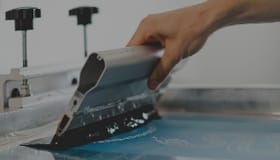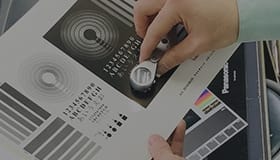2 Pack Ink for FIM/IMD Applications
2 Pack Ink for FIM/IMD Applications
Applicable scope of FIM/IMD inks has enlarged with newly developed "200 Catalyst". This report gives a brief information about using method of 2 pack FIM/IMD ink series (IPX, INQ) and all types of catalysts (200 Catalyst, 220 Catalyst, 240 Catalyst, 106 Catalyst).
1. Outline
Currently, there are IPX Ink Series and INQ Ink Series as 2 pack inks for FIM&IMD applications in Teikoku Printing Inks’ (hereafter Teikoku) product lineup.
Teikoku recommends IMB Binder Series as a binder layer between these inks and injection molding resin in FIM process.
2. Characteristics
| Product | Special Features | Substrates | Application Examples |
|---|---|---|---|
| IPX | Geneva, Arial, Helvetica, sans-serif; 2 Pack Screen Printing Ink for FIM/IMD *Ink layer resistance is superior → Printing on outer surface *High temperature and Wash out resistance *Suitable for wide range of applications. |
PC, Treated PET PC/PBT PMMA |
Automobile nameplate&interior, Cellular phone, Portable music devices, Home appliance nameplate, PC exterior, Display |
| INQ | *2 Pack Screen Printing Ink for FIM/IMD *Superior flexibility, particularly suitable for TPU substrate *Deep-drawing is possible |
TPU, Flexible Materials |
Cellular Phone, Membrane switch, Home appliance nameplate |
| IMB | *1 Pack Binder for FIM/IMD (Adhesive layer) *Standard screen printing ink printability as it is 1 Pack *Adhesive layer ink for injection molding resin to be used with 2-pack inks |
PC, Treated PET |
Adhesive layer for Injection molding resin in FIM. |
3. Positioning various types of Catalysts
Teikoku’s 2 pack insert molding inks (IPX, INQ) can perform in comply with specifications of final products according to selected catalyst. Catalysts and their features are as follows.
| 106 Catalyst | 240 Catalyst | 220 Catalyst | 200 Catalyst | |
|---|---|---|---|---|
| Elongation rate of ink layer when used with IPX | 130% | 140% | 170% | 250% |
| Characteristics | Improvement of Adhesion to material | Standard (IPX Standard) |
Flexible (INQ Standard) |
Highly Flexible |
Above-mentioned results are of tests performed in Teikoku and can not be guaranteed. Preliminary testing under actual conditions is strongly recommended before a commercial run.
4. How to use
Selection of IMB Binder
Select the IMB Binder according to injection molding resin used in FIM/IMD.
| Characteristic | Resin | Under layer Ink | |
|---|---|---|---|
| IMB-003 Binder | General Purpose | PC, PC/ABS, ABS, PMMA, AS | IPX, INQ |
| IMB-009 Binder | For Mirror Ink | PC, PC/ABS | MIR |
How to use the Ink
a) Mixing
Put thinner or catalyst and stir well just before using ink.
Standard thinner: F-003, standard dilution: 10~15%. F-002 thinner for fast dry and Z-705 thinner for slow dry are also available.
Standard Using Amounts of Catalysts
| 106 Catalyst | 240 Catalyst | 220 Catalyst | 200 Catalyst | |
|---|---|---|---|---|
| Characteristics | Improvement of Adhesion to material |
Standard (IPX Standard) |
Flexible (INQ Standard) |
Highly Flexible |
| IPX | 14% | 10% | 15% | 16% |
| INQ | 4% | 3% | 5% | 6% |
b) Drying
Heated drying at higher than 80 °C is required. (Refer to next section for initial and final drying conditions.) Insufficient dry causes lack of surface resistance due to insufficient hardening reaction.
c) Cleaning
Clean the stencil with screen cleaner immediately after use.
d) Storing
Even unmixed catalyst may harden by reacting the moisture in air. Containers should be closed tightly after use and stored in a cool, and dark place.
* Safety and Handling
Please ask for Teikoku’s product SDS. Read it carefully before handling products and handle all Teikoku products responsibly.
5. Do’s and Don’ts
| Do’s and Don’ts | Reason | |
|---|---|---|
| Ink | Use designated thinners and catalysts. | Other thinners or catalysts cause lack of performance. |
| Do not reuse the ink mixed with catalyst. | Usable period of ink (Pot life) after mixing catalyst is 4~5 hours at room temperature(25°C). | |
| Avoid adding excessive amount of catalyst. | Causes not only lack of performance but also degradation. | |
| Drying | Initial drying should be less than 10min. at 80°C. | Longer initial drying may cause Lifting. |
| Final drying at 90°C-60min. is recommended. | Absence of final drying causes Foaming and Wash out in FIM/IMD. | |
| Avoid excessive drying in forming.Eg. 90°C-240min., half day at 90°C etc. | Excessive drying increases the ink layer crack probability because of over bake. | |
| Printing Structure | Final drying is required after printing IMB Binder (Adhesive layer) in FIM/IMD applications. | If final drying is performed before printing IMB Binder, IMB Binder cannot adhere to Ink layer. |
| FIM/IMD ink printing, Initial drying, IMB Binder printing and Final drying should be done at same day in FIM/IMD applications. | Making the product wait may cause Lifting. | |
| FIM | Insert molding should be done within 1 week after creating the printed sheets. | Ink layer cracks during Insert molding because Catalyst begins reaction over time. |
| Please consult with Teikoku sales representative in case of crack or wash out. | Laboratory of Teikoku presents the detailed information. |
6. Other
- Size of printed area, mesh, printing conditions (temperature, humidity, etc.), performance of dryer etc. affect the drying properties, curing properties, insert molding suitability, and layer resistance of screen printing ink.
- Type of injection molding resin or insert molding conditions in FIM process affect the adhesion between ink layer and injection molding resin. Thus multiple factors, such as selection of binder, design printing ink, printing conditions, injection molding resin condition settings during the insert molding affects the performance of final product.
- Preliminary test should be performed in accordance with intended use.
- Above-mentioned using methods, attention items, performance data are result of tests applied in Teikoku and cannot be guaranteed. Preliminary testing under actual conditions is strongly recommended before a commercial run.
- Related technology information
-
- 150: Technology lecture for FIM/IMD 1st session: Explanation of the merit and 3 process.
- 151: Technology lecture for FIM/IMD 2nd session: Explanation of the screen printing process.
- 152: Technology lecture for FIM/IMD 3rd session: Explanation of the Forming Process.
- 153: Technology lecture for FIM/IMD Final session: Explanation of the Injection Process
- Related event information

